Related Research Articles
A horse breed is a selectively bred population of domesticated horses, often with pedigrees recorded in a breed registry. However, the term is sometimes used in a broader sense to define landrace animals of a common phenotype located within a limited geographic region, or even feral "breeds" that are naturally selected. Depending on definition, hundreds of "breeds" exist today, developed for many different uses. Horse breeds are loosely divided into three categories based on general temperament: spirited "hot bloods" with speed and endurance; "cold bloods," such as draft horses and some ponies, suitable for slow, heavy work; and "warmbloods," developed from crosses between hot bloods and cold bloods, often focusing on creating breeds for specific riding purposes, particularly in Europe.

The Cleveland Bay is a breed of horse that originated in England during the 17th century, named after its colouring and the Cleveland district of Yorkshire. It is a well-muscled horse, with legs that are strong but short in relation to the body. The horses are always bay in colour, although a few light hairs in the mane and tail are characteristic of some breed lines. It is the oldest established horse breed in England. The ancestors of the breed were developed during the Middle Ages for use as pack horses, when they gained their nickname of "Chapman Horses". These pack horses were cross-bred with Andalusian and Barb blood, and later with Arabians and Thoroughbreds, to create the Cleveland Bay of today. Over the years, the breed became lighter in frame as they were employed more as carriage and riding horses. The popularity of the Cleveland Bay has greatly fluctuated since it was first imported to the United States in the early nineteenth century. Despite serious declines in the population after the Second World War, the breed has experienced a resurgence in popularity since the 1970s, although only around 550 horses existed worldwide as of 2006.

The Lusitano, also known as the Pure Blood Lusitano or PSL, is a Portuguese horse breed. Horses were known to be present on the Iberian Peninsula as far back as 20,000 BC, and by 800 BC the region was renowned for its war horses. The fame of the horses from Lusitania goes back to the Roman Age, which attributed its speed to the influence of the West wind, who was considered capable of fertilizing the mares. When the Muslims invaded Iberia in 711 AD, they brought Arabian horses with them that were crossed with the native horses, developing a horse that became useful for war, dressage and bull fighting. The Portuguese horse was named the Lusitano, after the word Lusitania, the ancient Roman name for the region that modern Portugal occupies. There are four main breed lineages within the breed today, and characteristics differ slightly between each line.

The Russian Don is a breed of horse developed in and named after the steppes region of Russia where the Don River flows. Utilized originally as cavalry horses for the Cossacks, they are currently used for under-saddle work and driving.
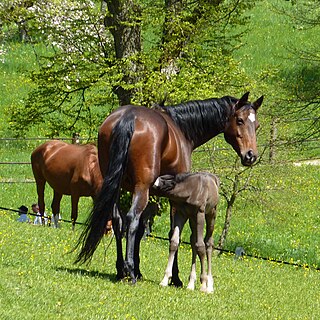
The Württemberger, Baden-Württemberger or Württemberg is a Warmblood horse breed originating in Germany. They are primarily riding horses, and are selectively bred for dressage and show jumping.

The Dole Gudbrandsdal, Dølahest, or Dole is a draft- and harness-type horse from Norway. The Dole Trotter is alternately considered a subtype of the Dole Gudbrandsdal and a separate breed; it is also considered a part of the coldblood trotter type. The Dole Gudbrandsdal is a small draft horse, known for its pulling power and agility, while the Dole Trotter is a smaller, faster horse used for harness racing; the two types are commonly interbred. Both types are strictly critiqued before entry into the studbook, which has over time resulted in an improvement in the breed type. The Dole is originally from the Gudbrandsdal Valley, and is probably descended in part from the Friesian horse. Over time, the breed has had Thoroughbred, Arabian, and other breeds added in, especially during the creation of the Dole Trotter in the 19th century. The first studbook was created in 1941, and the current breed association was formed in 1947. Although originally used mainly as a pack horse, today, the heavier Dole type is used mainly for agricultural purposes. The Dole Gudbrandsdal been crossed with other breeds to develop horses for harness racing and riding.
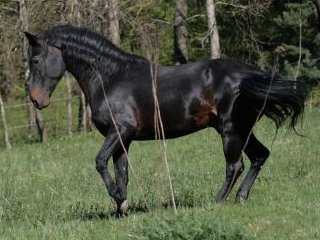
The Kabarda, Kabardin or Circassian horse is a breed from the Caucasus, originating from Eastern Circassia, currently part of the Kabardino-Balkaria region of Russia. Historically the breed has been known for at least 400 years, but its origins are probably as old as the Hittite civilization. These horses are noted for their endurance and ease to adapt in difficult environments.

The Budyonny is a breed of horse from Russia. It was bred as a military horse after the Russian Revolution of 1917; in the twenty-first century it is used as an all-purpose competition horse and for driving.
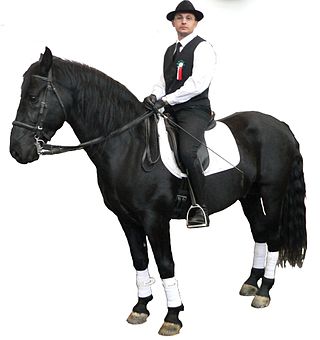
The Murgese horse originated in the Murge, Apulia area of Italy during the Spanish rule, and was developed from Barb and Arabian horses. They are a hardy breed that is used mainly for cross-country riding, although they have also been used for light draft work.
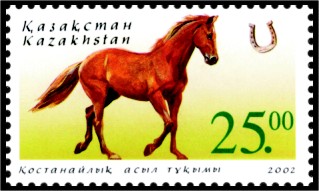
The Kustanair is a breed of horse developed in Kazakhstan in the former U.S.S.R. in the late 19th and early 20th centuries. They are used mainly for under-saddle and light draft work.
The Lokai, a mountain horse bred in Tajikistan, is used as a riding horse, a packhorse, or even sometimes a light draft horse. Although small, the breed is agile and hardy. The breed was developed by crossing native mountain horses with a mixture of Central Asian and European bloodlines.
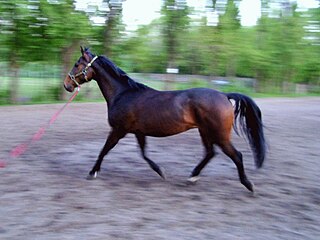
The Malopolski is a Polish horse breed developed in the 19th century in Lesser Poland, Polish Małopolska, hence the name. It is versatile breed, used today for light draft and under-saddle work. It was developed mainly from native Polish horses crossed with Thoroughbreds and Arabians, and a 2006 study shows a strong genetic presence of Thoroughbred bloodlines within the breed today. Population numbers have been in decline since the late 20th century, but genetic studies show little danger of inbreeding at this time.

The Jutland horse is a draft horse breed originating in Denmark, named after the Jutland Peninsula which forms the western part of the country. Usually chestnut, they are a compact, muscular breed known for their calm and willing temperament. The breed was originally developed for use in agriculture, but today is more often seen in urban settings and at horse shows. Some of the best known members of the breed pull beer wagons for the Carlsberg brewery around Copenhagen, as well as at competitions and for demonstrations. Images from the 9th century show a horse similar to the Jutland being used by Viking raiders in what is now Great Britain. The first written record is from the 12th century, when they were popular as war horses. Some infusion of bloodlines from other breeds occurred in the 18th century, but the modern Jutland type only began about 1850 with the addition of blood from several other breeds, mainly draft horses. A stud book was created in the late 19th century, and the Jutland population grew to a maximum around 15,000 by 1950. Numbers subsequently declined, and as of 2011, only an estimated 1,000 horses remained.

The French Saddle Pony, also called the Poney Français de Selle, is a pony breed developed as a sport pony for children and smaller adult riders. It was initially developed in 1969 as the Poney de Croisement, and in 1972 a stud book was created. In 1991 the stud book was closed and the breed renamed to Poney Français de Selle. The breed combines a mix of French and British pony breeds, as well as Thoroughbred and Arabian blood, to create the horse seen today. Due to the large number of breeds used to create the French Saddle Pony, there is not yet a defined set of physical characteristics for the breed, although all tend to be suited for competition in English riding disciplines, including dressage, show jumping and three-day eventing. They fill a similar role as the British Riding Pony and the German riding pony.

The Italian Heavy Draft, or Rapid Heavy Draft, is a breed of draft horse from Italy. The full Italian name of the breed is Cavallo Agricolo Italiano da Tiro Pesante Rapido, "Italian Rapid Heavy Draft Farm Horse", and the abbreviation TPR ) is often used.

The Deutsche Reitpony or German Riding Pony is a very popular pony breed in Germany. It is described as a "miniature warmblood" with refined, horse-like characteristics that make it suitable as both a children's pony and as a mount for sport horse competition in Europe. Originally bred in Germany and later throughout Western Europe, the breed is relatively new to North America.
The Karacabey horse is a now-extinct horse breed. It was a light riding horse that originated in Turkey.
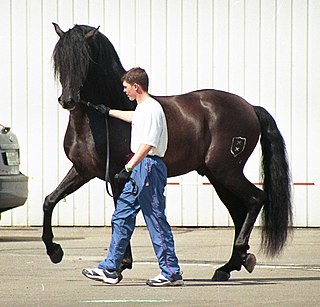
The Andalusian, also known as the Pure Spanish Horse or PRE, is a horse breed from the Iberian Peninsula, where its ancestors have lived for thousands of years. The Andalusian has been recognized as a distinct breed since the 15th century, and its conformation has changed very little over the centuries. Throughout its history, it has been known for its prowess as a war horse, and was prized by the nobility. The breed was used as a tool of diplomacy by the Spanish government, and kings across Europe rode and owned Spanish horses. During the 19th century, warfare, disease and crossbreeding reduced herd numbers dramatically, and despite some recovery in the late 19th century, the trend continued into the early 20th century. Exports of Andalusians from Spain were restricted until the 1960s, but the breed has since spread throughout the world, despite their low population. In 2010, there were more than 185,000 registered Andalusians worldwide.

A part-Arabian, partbred Arabian or, less precisely, half-Arabian, is a horse with documented amounts of Arabian horse breeding but not a purebred. Because the Arabian is deemed to be a breed of purebred horse dating back many centuries, the modern breed registries recognized by the World Arabian Horse Organization generally have tightly closed stud books which exclude a horse from registration if it is found to contain any outside blood. However, Arabian breeding has also been used for centuries to add useful traits to countless other horse breeds. In the modern era, crossbreeding has been popular to combine the best traits of two different breeds, such as color, size, or ability to specialize in a particular equestrian discipline.